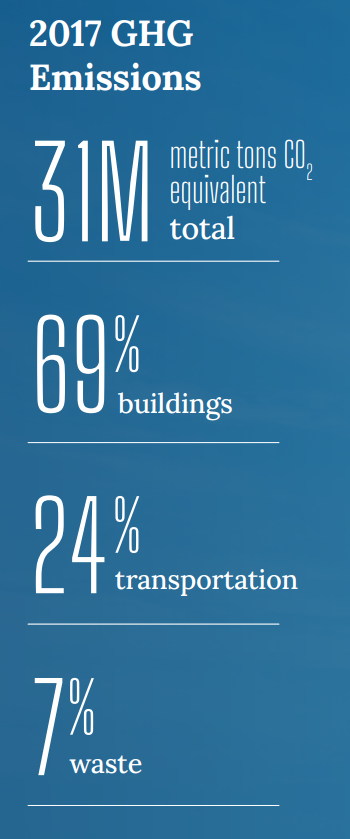Electrify Chicago
An independent tool for viewing City of Chicago building data
According to the
2022 Chicago Climate Action Plan,
69% of Chicago's emissions come from buildings, making
building emissions our biggest challenge and our biggest opportunity as a city
to tackle climate change. At Electrify Chicago, we showcase building performance using
publicly available data supplemented by community-submitted photographs and building
owners.
Start by looking at Chicago's buildings with the highest greenhouse gas intensity i.e. emissions per square foot. Large, efficient, buildings can perform much better than very inefficient small buildings on this metric.
New Article
📰 $30 Million In Missed Fines
The City Of Chicago failed to collect $30 million in potential fines from the building benchmarking ordinance, reducing transparency and accountability.
Legislative update! 🎉
As of late January 2024, legislation is being introduced to require new use more efficient forms of water and space heating, via the Clean And Affordable Buildings Ordinance (CABO), which will reduce the number of highly polluting and inefficient buildings that end up on this site.
If you're in Chicago,
write to your alderman to support the CABO!
Chicago Buildings by Greenhouse Gas Intensity
Note: Data includes large Chicago buildings with data from 2022, unless explicitly stated otherwise.
Note: This data only includes buildings whose emissions are reported
under the
Chicago Energy Benchmarking Ordinance. According to the City “As of 2016,
this list includes all commercial, institutional, and residential buildings larger than
50,000 square feet.” This dataset is also then filtered to only buildings with
reported emissions > 1,000 metric tons CO2 equivalent.
The latest year of data is from 2022, but we update the site regularly when new data is available, and some buildings may have failed to report that year, and only have older data available.
| Property Name / address | Primary Property Type |
Greenhouse Gas Intensity (kg CO2 eq./sqft) |
Total Greenhouse Emissions (metric tons CO2 eq.) |
|---|---|---|---|
|
Walmart Supercenter #5617
🕰️
4626 W Diversey Ave
| Wholesale Club/Supercenter | 11.7 kg/sqft | 1,360 tons |
|
Latin School of Chicago Upper School
🕰️
59 W. North BLVD
| K-12 School | 11.7 kg/sqft | 1,780 tons |
|
Hyde Park Tower
5140 S Hyde Park Blvd
| Multifamily Housing | 11.7 kg/sqft
Highest 9%
| 1,683 tons
Highest 28%
|
|
(ILCH1212) - Park Michigan [external]
1212 S Michigan Ave
| Multifamily Housing | 11.7 kg/sqft
Highest 9%
| 2,797 tons
Highest 15%
|
|
Blackhawk and Hallstead
🕰️
1460 N Halsted St
| Mixed Use Property | 11.7 kg/sqft | 2,618 tons |
|
Symphony of Chicago West
5130 W JACKSON BLVD
| Senior Living Community | 11.7 kg/sqft
Highest 9%
| 1,295 tons
Highest 37%
|
|
860 N DEWITT PL
🕰️
860 N DEWITT PL
| Multifamily Housing | 11.7 kg/sqft | 1,455 tons |
|
The Hoxton
200 N Green St
| Hotel | 11.6 kg/sqft
Highest 9%
| 1,779 tons
Highest 26%
|
|
Virgin Hotels Chicago
🕰️
203 209 N WABASH AVE
| Hotel | 11.6 kg/sqft | 2,299 tons |
|
217 221 N JEFFERSON ST
217 221 N JEFFERSON ST
| Office | 11.6 kg/sqft
Highest 9%
| 676 tons
Lowest 39%
|
|
Danny Cerero
🕰️
161 W 9th St
| K-12 School | 11.5 kg/sqft | 872 tons |
|
180 N Wabash Ave
180 N Wabash Ave
| Office | 11.5 kg/sqft
Highest 9%
| 1,871 tons
Highest 25%
|
|
Garvey Elementary -CPS
🕰️
(CPS)
10309 S Morgan St
| K-12 School | 11.5 kg/sqft | 637 tons |
|
521 531 S DEARBORN ST
521 531 S DEARBORN ST
| Multifamily Housing | 11.5 kg/sqft
Highest 9%
| 647 tons
Lowest 37%
|
|
3601 3613 S WELLS ST
3601 3613 S WELLS ST
| Multifamily Housing | 11.5 kg/sqft
Highest 9%
| 1,006 tons
Highest 45%
|
Data Source:
Chicago Energy Benchmarking Data
